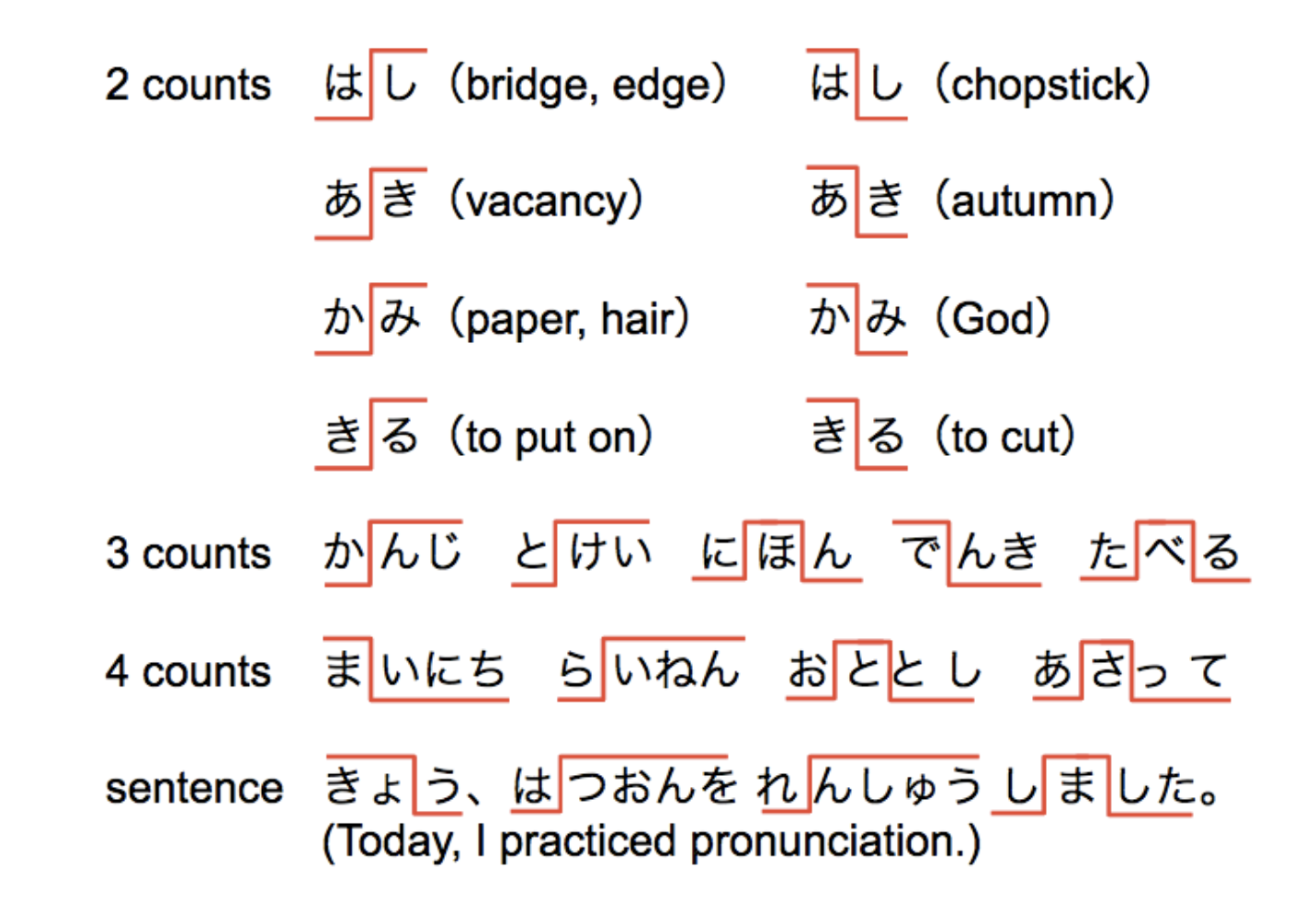For any and all of you who wants to speak and pronounce words like a Japanese native, I have compiled this list of five useful quick fixes. You can start from anywhere on this list or just focus on what you want to improve.
Quick Fix #1: Relax your mouth, tongue and lips (Practice the five vowels)
You don't have to move your mouth, tongue or lips very much. Take a big yawn, exhale, and loosen your face. Then, try practicing the five Japanese vowels あ [a], い [i], う [u], え [e] and お [o] by following the instructions below.
Quick Drill
Practice each vowel sound more than five times.
あ [a] Take a deep breath and exhale all at once with a sigh. Do it once more, this time making a sound like "ah" (as in arch) while exhaling. This is very much like the あ [a] sound. い [i] Put your upper teeth and lower teeth close together and relax your lips. Place the middle of your tongue close to the roof of your month and say い [i]. You should keep in mind that this sound is more like the English [ee] than the English [i] (“ee” as in feet). う [u] Slightly purse your lips (though not as strongly as in the English [w] sound). Take a breath and make a sound like “oo” while exhaling (as in rooster). This is very close to the う [u] sound. え [e] This is similar to the English [e] sound, but you should relax your face and lips more when you say the Japanese え [e] (as in elephant). お [o] Open your mouth and slightly round your lips. Then say the Japanese お [o] like “o” (as in orange). |
If you need sound samples and visualized instructions, watch this.
Quick Fix #2: Master distinct Japanese sounds (Practice double consonants)
Fuzzy double consonants sounds are what allow Japanese people to determine whether a speaker is native or not. Use these quick fixes to make your double consonants sound more natural.
Double Consonants: A set of double consonants is represented by the small character っ. The whole idea is to put your mouth, lips and tongue in the position of the next consonant and then to pause for a millisecond. In this millisecond of っ, you almost stop breathing.
Quick Drill
Count once for each character, including っ, while pronouncing the following. In other words, you should read each one by counting “one,” “two,” “three” and focusing on っ. You should also be sure to not make any noise for っ; just count one beat while waiting to say the next consonant. Start slowly, making sure to pronounce everything precisely. You should practice each word more than five times.
- きって [ki t te]
- カップ [ka p pu]
- ざっし [za sh shi]
- とった [to t ta]
- かっこ [ka k ko]
- がっき [ga k ki]
- トップ [to p pu]
- ばった [ba t ta]
- りっぱ [ri p pa]
- さっか [sa k ka]
- ポップ [po p pu]
Quick Fix #3: Master distinct Japanese sounds (Practice N sounds)
I intentionally wrote ん [N] sounds, instead of making it singular. The definition of ん [N] is a nasal sound pronounced with the same mouth position as the consonant that follows. Please be careful, as this is different from the English [n] sound. During the millisecond that you are pronouncing the ん [N] sound, prepare your mouth for the next consonant and produce a nasal sound.
Quick Drill
Slowly read the following words, which are accompanied by the English pronunciation symbol that is the most similar. Practice reading them, paying special attention to the movement of your lips and tongue.
ん [m] Similar to the English [m] sound, ん [m] comes before the [p], [b] and [m] sounds. さんぽ [sa m po] 、コンパ [ko m pa]、キャンプ [kya m pu], とんぼ [to m bo]、コンビ [co m bi]、サンバ [sa m ba], さんま [sa m ma]、コンマ [ko m ma] ん [n] べんり [be n ri]、さんそ [sa n so]、ボンド [bo n do]、ほんとう [ho n to o]、みんな [mi n na] 、こんにちは [ko n ni chi wa] Don’t pronounce [mina] for みんな or [koni chiwa] for こんにちは as you would in English. ん [ŋ] Similar to the English [ŋ] sound, ん [ŋ] is very much like the nasal sound used in “-ing” [ŋ] and comes before the [k] and [g] sounds. りんご [li ŋ go]、たんご [ta ŋ go]、こんご [ko ŋ go]、さんこ [sa ŋ ko]、きんこ [ki ŋ ko]、きんぎょ [ki ŋ gyo]、ぎんか [gi ŋ ka] When you pronounce ん before vowels, [y] or [w], be sure to separate ん from them. れんあい [re ŋ a i]、はんい [ha ŋ i]、はんえい [ha ŋ e i]、こんや [ko ŋ ya]、しんゆう [shi ŋ yu u]、でんわ [de ŋ wa] |
Quick Fix #4: Count each character equally (Get familiar with a regular beat!)
I often hear students use shorter long vowels, double vowels/consonants and N sounds, all of which make their pronunciation sound “non-native.” Please be aware that each character should have the same length in sound. The only exceptions are modified syllables like きゃ [kya] and しょ [sho], which are combinations of hiragana and a small ゃ、ゅ、ょ. You should count once for each modified syllable. In order to get familiar with the regular beat, follow the instructions below and make some noise. Be a kid again and enjoy!
Quick Drill
- You are a drummer making a steady and regular beat. Grab two pens or sticks, one in each hand, and make noise on your desk. You can also use two fingers or a metronome app instead.
- Start with a slow tempo like andante (72) and create a regular beat for a while. Then start reading the following words. Use one count for each character. Once you are familiar with the tempo, speed up little by little.
Two counts:
- あい、うえ、おい、いえ、えき、かい、きょう[kyo-o]、ほん、いい、しゅみ、かん
Three counts:
- にほん、かんじ、きのう、きょねん、みっか、とおか、こんど、じかい、ざっし、まんが、きいろ、ちゃいろ、とおい、きれい、さっき、きって、がっき、ばった、しゃしん、さっか、ポップ、ケーキ、カップ、シャワー
Four counts:
- にほんご、きょうかしょ、れんしゅう、しつもん、らいねん、おととい、あさって、とうきょう、しんじゅく、ゆうめい、かわいい、たのしい、きょうかい、けいたい、スマート、キャラメル
Five counts:
- ありがとう、おもしろい、かっこいい、すばらしい、うつくしい、あきはばら、いけぶくろ、さんごしょう、ヨーロッパ、ニューヨーク、フライパン
Quick Fix #5: Create tidy up and down waves (Practice the Japanese accent)
The type of accent used in the Japanese language is a "pitch accent," which has up and down tones. This is different from emphasis accents like in English or tone accents like in Chinese. You might have seen these accent symbols in your Japanese textbook.

Basically, there are only four accent types. C and D are almost the same, however, the accent of a particle following a noun is different.
Good news! There is only one simple rule: the accents of the first and second syllables are always opposite.
Quick Drill
- Be a musician! Use a musical instrument such as a keyboard or guitar (if you have one) or find two empty cans or something else that can produce two slightly different tones. For a musical instrument, use “doh” (C) for the lower tone and “mi” (E) for the upper tone.
- Look at the words and short sentences with Japanese accent symbols below.
- First choose one word, then create upper tones and lower tones on the regular beat in accordance with the accent symbols. Do it several times until you memorize the tones and beat in your mind.
- Second, read the word aloud, imitating the instrument’s sound that you’ve created. Practice several times until you get familiar with it, then move on to the next word or sentence.

If you need a complete accent dictionary, look here or here for reference.
Did you have fun with this? Come practice with me and I will give you more tips on the pronunciation of consonants and on intonation in order to help you improve your speech. Hope to see you soon!







